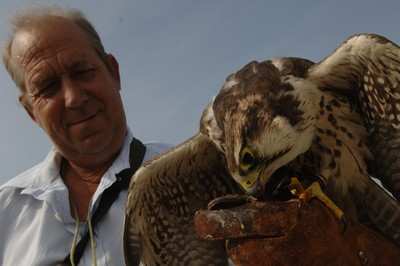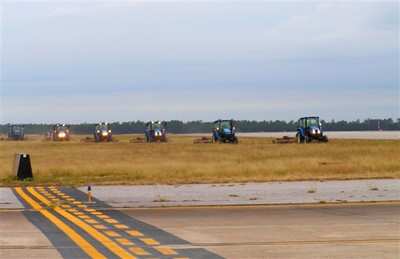Avian Encounter Downed E-3B In 1995
As an ongoing investigation continues on a bird strike that
caused a passenger jet's engines to fail last week after takeoff
from New York's LaGuardia Airport, Air Force safety officials said
they're well-versed on the dangers of bird strikes and aggressively
are working to prevent them.

National Transportation Safety Board officials confirmed initial
indications that
US Airways flight 1549 struck a flock of
birds, which were sucked into the engines and caused
them to fail. The pilot, former Air Force pilot Chesley B. "Sully"
Sullenberger III, successfully landed the plane in New York's
Hudson River and is credited with saving all 155 people on
board.
The incident brought public focus to a problem the Air Force,
along with the airline industry, has long struggled to
overcome.
Last year alone, the Air Force experienced more than 4,000 bird
strikes, Eugene LeBoeuf, chief of the Air Force's Bird/Wildlife
Aircraft Strike Hazard, or BASH, program at Kirtland Air Force
Base, NM, told American Forces Press Service.
Fortunately, none of those bird strikes was classified as a
"Class A" accident, one that results in a death or more than $1
million in damages, LeBoeuf said. But collectively, they cost the
Air Force an estimated $35 million.
 Bird strikes are on the rise, he said, and present a serious
safety issue. The crash of an E-3B Airborne Warning and Control
System plane in 1995 after takeoff from Elmendorf Air Force Base,
AK painfully drove that point home. All 24 crew members died when
the plane struck a flock of Canada geese just after takeoff.
Bird strikes are on the rise, he said, and present a serious
safety issue. The crash of an E-3B Airborne Warning and Control
System plane in 1995 after takeoff from Elmendorf Air Force Base,
AK painfully drove that point home. All 24 crew members died when
the plane struck a flock of Canada geese just after takeoff.
"When you have a bird strike, it's like throwing a rock into the
engine," said Air Force Staff Sgt. Paul White, airfield operations
supervisor at Andrews Air Force Base, MD. "It stops the turbine
from spinning, and that can be catastrophic."
The BASH program works to avert accidents like the one at
Elmendorf and last week's incident in New York. Based on a system
of "integrated pest management," it aims to keep air bases,
airfields and the air space and ground in and around them free of
birds and wildlife that can hamper aircraft operations, LeBoeuf
explained.
That's a challenge, he said, with more Canada geese taking up
permanent residence in the United States, a burgeoning snow goose
population and a comeback for the pelican population after DDT and
other insecticides were banned.
But birds aren't the only problem, LeBoeuf said. He's seen it
all: deer, coyotes, wild pigs and even alligators finding their way
onto Air Force flightlines. "They're mobile speed bumps, and
aircraft don't take kindly to them," he said.
Step one in the BASH program is "habitat alteration," which
LeBoeuf defined as making airfields as uninviting as possible.
Anything that might serve as a perch is removed, denying birds an
elevated place to roost. Potential perches that can't be removed
get spikes driven into them.

Meanwhile, low spots in the land where birds can hide or seek
water that collects are filled in.
Dan Vredenburgh, a contractor who oversees Andrews Air Force
Base's BASH program, follows the Air Force protocol of ensuring
grass around the airfield is maintained between 7 and 14 inches.
That's too short for ground birds to nest in, but too long for them
to feel safe feeding in, he explained.
"These are the benign approaches, but if they don't work, we
turn to more active techniques," LeBoeuf said. In a word, he
defined that as "harassment."
Vredenburgh, for example, has a whole list of tricks to make
Andrews unwelcoming to seagulls, blackbirds, starlings, turkey
vultures, cowbirds, ducks and geese that frequent the region.
He fires off pyrotechnics and propane cannons as needed to scare
birds from the 4,320-acre base. One of his most effective tools is
Bree, a two-tone border collie that chases away birds or other
wildlife that might be tempted to take up residence. Vrendenburg
and Bree patrol the base regularly, and he sets her loose when he
discovers birds roosting.
"When she takes off, they leave in a hurry," Vrendenburgh said.
"After a couple of times, they probably won't come back."
Other bases use different techniques. The Royal Air Force base
at Mildenhall in England, for example, relies on a Moroccan lanner
hawk named Goldie to ward off unwanted birds. At Manas Air Base in
Kyrgyzstan, a luger falcon named Mustang helps to keep unwanted
birds at bay.
But no preventive measure will keep birds and other wildlife
away indefinitely, LeBoeuf said. So as a last resort, BASH
officials get the permits required to shoot, trap or otherwise
remove them from the area.
At Andrews -- home of the 316th Wing as well as the 89th Airlift
Wing that flies Air Force One and other aircraft in support of the
president, vice president and senior US leaders -- these measures
are helping to reduce bird strikes.
Andrews reported 20 bird strikes last year, down from 30 in
fiscal 2007 and an average of about 34 a year in past years,
Vredenburgh said. Nearly all involved small birds, and none
inflicted major aircraft damage or forced an emergency landing.

"We understand the importance of what we do, and believe we're
helping reduce the problem through our efforts," he said.
"There's no question that the BASH program is making a
difference," LeBoeuf said. "It saves lives and aircraft and allows
us to maintain our mission. It's a very important program."
(Aero-News thanks Donna Miles, American Forces Press
Service)
 ANN's Daily Aero-Term (04.14.24): Maximum Authorized Altitude
ANN's Daily Aero-Term (04.14.24): Maximum Authorized Altitude ANN's Daily Aero-Linx (04.14.24)
ANN's Daily Aero-Linx (04.14.24) Classic Aero-TV: 'We're Surviving'-- Kyle Franklin Describes Airshow Life 2013
Classic Aero-TV: 'We're Surviving'-- Kyle Franklin Describes Airshow Life 2013 Aero-News: Quote of the Day (04.14.24)
Aero-News: Quote of the Day (04.14.24) Airborne 04.09.24: SnF24!, Piper-DeltaHawk!, Fisher Update, Junkers
Airborne 04.09.24: SnF24!, Piper-DeltaHawk!, Fisher Update, Junkers






